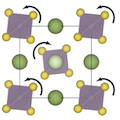Abstract
Solid electrolytes are crucial for next-generation solid-state batteries, and Na3PS4 is one of the most promising Na+ conductors for such applications, despite outstanding questions regarding its structural polymorphs. In this contribution, we present a detailed investigation of the evolution in structure and dynamics of Na3PS4 over a wide temperature range 30 < T < 600 ℃ through combined experimental−computational analysis. Although Bragg diffraction experiments indicate a second-order phase transition from the tetragonal ground state (α) to the cubic polymorph (β) above ∼250 ℃, pair distribution function analysis in real space and Raman spectroscopy indicate remnants of a tetragonal character in the range 250 < T < 500 ℃, which we attribute to dynamic local tetragonal distortions. The first-order phase transition to the mesophasic high-temperature polymorph (γ) is associated with a sharp volume increase and the onset of liquid-like dynamics for sodium-cations (translational) and thiophosphate-polyanions (rotational) evident by inelastic neutron and Raman spectroscopies, as well as pair-distribution function and molecular dynamics analyses.These results shed light on the rich polymorphism of Na3PS4 and are relevant for a host of high-performance materials deriving from the Na3PS4 structural archetype.
